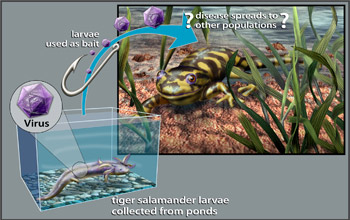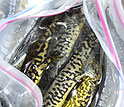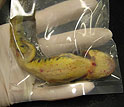News Release 09-059
Spring Fishing Season Arrives ... And With It, Amphibian Diseases
Bait shop trade likely source of pathogen spread in salamanders

Biologists have discovered that amphibian diseases are spread by bait shops.
April 6, 2009
This material is available primarily for archival purposes. Telephone numbers or other contact information may be out of date; please see current contact information at media contacts.
Waterdogs, they're called, these larvae of tiger salamanders used as live bait for freshwater fishing.
With tiger salamander larvae, anglers hope to catch largemouth bass, channel catfish and other freshwater fishes.
They may be in for more than they bargained for: salamanders in bait shops in Arizona, Colorado and New Mexico are infected with ranaviruses, and those in Arizona, with a chytrid fungus called Batrachochytrium dendrobatidis (Bd).
"These diseases have spread with the global trade in amphibians,'" says James Collins, assistant director for biological sciences at the National Science Foundation (NSF). Collins is currently on leave from Arizona State University. "The commercial amphibian bait trade may be a source of 'pathogen pollution.'" Pathogens are disease-causing agents such as some viruses and bacteria.
Along with biologist Angela Picco of the U.S. Fish and Wildlife Service in Sacramento, Calif., Collins screened tiger salamanders in the western U.S. bait trade for both ranaviruses and Bd, and conducted surveys of anglers to determine how often tiger salamanders are used as bait, and how frequently the salamanders are let go in fishing waters.
The scientists also organized bait-shop surveys to determine whether tiger salamanders are released back into the wild after being housed in shops.
"We found that all tiger salamanders that ended up in the bait trade were originally collected from the wild," says Picco. "In general, they were moved from east to west and north to south--bringing with them multiple ranavirus strains."
Results of the research show that 26 to 73 percent of fishers used tiger salamanders as bait; 26 to 67 percent of anglers released tiger salamanders bought as bait into fishing waters; and four percent of bait shops put salamanders back in the wild after the waterdogs were housed with infected animals.
"The tiger salamander bait trade in the western U.S. is a good model for understanding the consequences of unregulated movement of amphibians and their pathogens," says Collins.
Examples of pathogen pollution are many and dramatic.
Europeans grazed cattle in African savannas, thereby introducing rinderpest, which resulted in massive losses of native African animals and changes to an entire ecosystem.
The import of Japanese chestnuts to the U.S. led to the introduction of chestnut blight, which nearly eradicated American chestnuts.
An international trade in and transport of infected timber spread Dutch elm disease throughout North America, Europe and Southwest Asia.
In the case of amphibians and reptiles, millions of kilograms of the animals may be shipped across the U.S. border each year.
"Many of them are not coming alone," says Picco. "They've got company: ranaviruses and Bd."
Waterdogs have been used as bait for at least 40 years. In 1968, 2.5 million tiger salamander larvae were sold as bait in the lower Colorado River area alone. Waterdogs in that one year were worth $500,000, equivalent to $2,766,489 in 2005 after adjusting for inflation.
"Since the tiger salamander bait trade isn't regulated or controlled in most areas of the western United States," says Picco, "there's no information about the number of individuals collected or traded annually."
She and Collins used the Web site www.baitnet.com to find a listing of bait shops in Arizona. Fourteen shops sold waterdogs, all of which were sampled in their study. The scientists collected 30 waterdogs per bait shop each month, or as often as the salamanders were available.
From March to October of 2005, 85 percent of Arizona bait shops sampled sold at least one ranavirus-infected tiger salamander.
In 2006, ranaviruses were detected in the tiger salamander bait trade between May and October in Arizona, New Mexico and Colorado, but were not found in the few bait shops sampled in Nebraska and Texas.
Three of nine shops tested in Arizona in 2007 had animals with Bd.
"If the presence of a pathogen in bait-trade salamanders is narrowed to several distributors, the movement of animals from these dealers could be stopped," says Collins.
"A quarantine program would help prevent the introduction of non-native pathogens into threatened, susceptible populations," he says. "Random monitoring of pathogen movement through the bait trade may help limit the spread of amphibian diseases."
Collins and Picco published a paper reporting the findings in Volume 22, Number 6,of the journal Conservation Biology.
-NSF-
-
A majority of anglers in Arizona, Colorado, and New Mexico uses waterdogs as bait.
Credit and Larger Version -
Waterdogs, or tiger salamander larvae, in bait shops across the U.S. West carry infections.
Credit and Larger Version -
Infectious diseases are affecting populations of amphibians, from frogs to salamanders.
Credit and Larger Version
Media Contacts
Cheryl Dybas, NSF, (703) 292-7734, email: cdybas@nsf.gov
Related Websites
Outbreak: Rapid Appearance of Fungus Devastates Frogs, Salamanders in Panama: http://www.nsf.gov/news/news_summ.jsp?cntn_id=105788
The U.S. National Science Foundation propels the nation forward by advancing fundamental research in all fields of science and engineering. NSF supports research and people by providing facilities, instruments and funding to support their ingenuity and sustain the U.S. as a global leader in research and innovation. With a fiscal year 2023 budget of $9.5 billion, NSF funds reach all 50 states through grants to nearly 2,000 colleges, universities and institutions. Each year, NSF receives more than 40,000 competitive proposals and makes about 11,000 new awards. Those awards include support for cooperative research with industry, Arctic and Antarctic research and operations, and U.S. participation in international scientific efforts.
Connect with us online
NSF website: nsf.gov
NSF News: nsf.gov/news
For News Media: nsf.gov/news/newsroom
Statistics: nsf.gov/statistics/
Awards database: nsf.gov/awardsearch/
Follow us on social
Twitter: twitter.com/NSF
Facebook: facebook.com/US.NSF
Instagram: instagram.com/nsfgov





